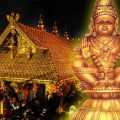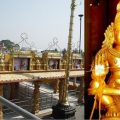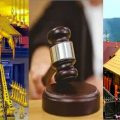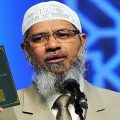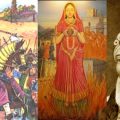Forgotten 1st Attack on Sabarimala; 2nd Attack Reminds Danger to Hindu Culture
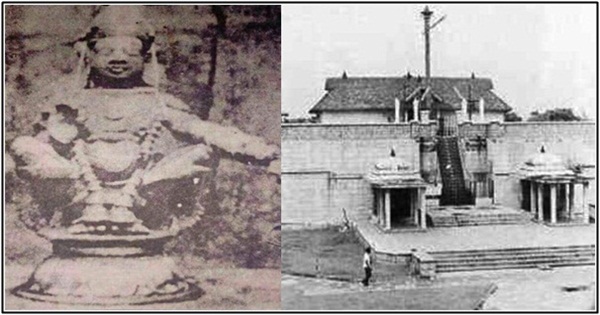
The Supreme Court verdict that women, of all age group, can enter Sabarimala temple in Kerala, is a thrash to Hindu traditions and practices, a danger to Hindu culture. That menstruating women should not visit the shrine has been a tradition born from the belief that the Ayappa deity is a ‘naishtika brahmachari’ (eternal celibate). Entry of women above the age of 10 and below the age of 50 has been prohibited.
The ancient shrine of Ayappa at Sabarimala is one of the largest annual pilgrimages in the world with an estimated 45–50 million devotees visiting every year. It is located at Perunad on a hilltop amidst 18 hills in the Western Ghats. The temple is open for worship only during certain days of the year – Makar Sankrant, Maha Vishuva Sankranti, 1st five days of each Kolliavarsham, and during Mandalapooja (November-December). Sabarimala devotees wear black or blue dress and keep a fast for 41 days.
Do you know Sabarimala Temple was the target of Christian missionaries? In 1950 there was an attempt by Christians to destroy the temple. This first attack on Sabarimala has been forgotten. Here is the Enquiry Report of Shri K. Kesava Menon, Deputy Inspector- General of Police, Special Branch, OLD (On Special Duty) on the Sabarimala temple arson case (put as it is in parts).
‘The first information in this case to the Police was on the night of l6th June 1950, when the Devaswom Commissioner and the President of the Devasowm Board informed the Inspector-General of Police that when the Santhikaran went to the Sabarimala Temple on the 14th June 1950, he found the Sreekovil, the Mandapam and the store-room completely gutted by fire and the Idol damaged…’
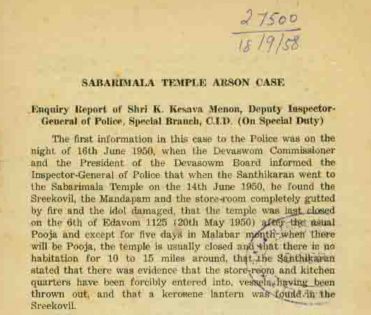
‘The District Superintendent of Police, Quilon and Party who visited the temple at the earliest opportunity found the following:
1. There were 15 cut marks of violence on the door leading to the Sreekovil indicating forcible entry into the Sreekovil. The existence of such marks goes against the theory of accident.
2. The idol was found broken, the head, left hand palm and fingers separated. There were cut marks on the Face of the idol as well as on the forehead.’
‘If the breaking of the idol alone is taken into consideration, a possible point that the rafters and other copper and other appliances of the roof of the Sreekovil could have fallen down on the idol and caused the damage arises for scrutiny, but the marks of violence on the brass-plated door of the Sreekovil together with the marks on the idol, raise the irresistible conclusion that the forcible entry into the Sreekovil was for the purpose of breaking the idol and that the weapon that was used to cause the cut marks on the door was the same used to break the idol. At the scene of occurrence, there was an axe and it is definite that that axe was used to cut the Sreekovil door, as traces of brass were found on the sharp edge of the axe, and hence it has to be said that the fire was not accidental.’
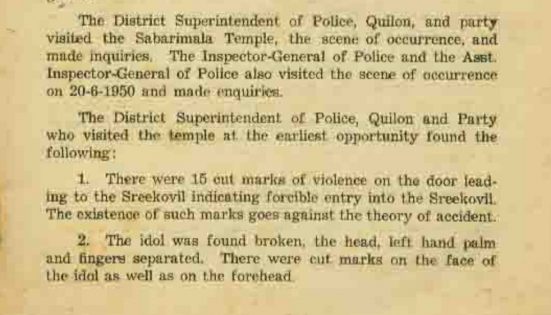
‘Next it may be argued that the entry was for committing theft, but apparently that does not seem to be the motive, since nothing valuable, viz., silver, gold and other utensils which were inside have been removed.’
‘The possibility of fire around the forest area enveloping the temple and thus bringing about the destruction of the temple is also out of the question, as there were no signs of any such forest fire around the area, and there were sample indications of a deliberate setting fire of the temple at the scene. The temple and surrounding building as already mentioned having been built of mostly non-infammable materials, could not be easily-set fire to and on a modest calculation, the perpetrators could have worked at this at least for four to five hours continuously, as evidenced from the emptying of the ghee tins and utilising cloth and other materials to set fire to the temple. Further, there were signs of occupation of the temple premises by a party. They have made use of the provisions that were stored in the temple including corriander. These clearly show that great labour has been undertaken in committing this act.’
‘After having explained that theft was not the motive of the offenders, the next point for consideration is to find out what else is the motive and who could possibly have that motive. From the examination of the scene of occurrence and attendant circumstances, it was possible to come to a conclusion that the offence was a deliberate one well conceived and executed. There was a touch of open vandalism and desecration was the only purpose. The breaking of the idol after forcibly entering into the Sreekovil by cutting open the door with an axe indicates ferocity.’
‘Though it will not be correct to state that there are no Hindus who are not acquainted with the place and route, it is reasonable to consider that Christians have got more familiarity and knowledge than the Hindus in this direction, as they and they alone occupy the places at the base of these hills and they are the only persons who hunt and poach in the vicinity of the temple day in and day out. In short, they have more facilities to commit this crime than any other community; and it is in evidence that they have hunted and poached in the vicinity during the relevant period. The forest lands and ‘the areas either at the beginning of these routes or lying along these routes are all cultivated not by the Hindus but by the Christians. The Hindus have not and cannot have so much of opportunities as the Christians. A Christian has absolutely no regard for a Hindu temple or idol. To him a Hindu idol is either a piece of stone or a block of metal. In short, he attached no sacredness for any Hindu idol or temple except that he may admire as a work of art. It is otherwise for a Hindu.’
‘The Hindus of South India do believe in the mythological aspect of this Forest Deity AYYAPPA and there are innumerable stories, perhaps with historical background, creating a belief in the sacredness of this ancient temple with such devotion where reason or rationalism have no place. In short, there are thousands and thousands of Hindus of South India who believe ‘that a visit to the temple and offerings there in the orthodox fashion would advance them much in their material prosperity and would be a shield against all dangers that are likely to happen to them. All Hindus without caste, creed or colour have such feelings of devotion towards this deity. The deity is a forest deity and the general belief amongst the Hindus is that wild animals could be controlled by calling the name of God AYYAPPA. For example, even the wild animals go away when one mentions aloud the name AYYAPPA.’
‘…Investigation having pointed out the hand of Christians on circumstantial evidence, the details of which I have given below, it is natural to believe that the above facts related to the motive are not inconsistent with the evidence gathered. I am emphasizing the point to show that the case was investigated as an ordinary Arson case on other important circumstantial findings with a view to trace the offenders, in which the motive point was not taken into consideration to begin with, and after investigating this on the lines mentioned above, and having arrived at conclusions, the motive point came in naturally in the wake of investigation.’
‘…Exhaustive and thorough inquiries were made and as a result the movements and activities of the following parties were brought to light.
1. Ouseph Thomman alias Vattakunnel Kunhupappan and his party.
2. Pezhathumveettil Chacko, Malayanikkal Kochu and three coolies
3. Adakkamundakkal Kunhappi and Malamakkal Skariya
4. Pezhathumveettil Ouseph and others.’
‘Party No I: This party consisted of six members. They are all Roman Catholics and are residents of Kombanpara, near Mathamba estate. Anthony, one of the members of the party, is his own brother. Paili, another member, is employed in the Game Association as a Game Watcher. Thomman and Devaasya are two brothers and are neighbours of Kunhupappan. Naripara Kutti is another neighbor. Kunhupappan and Thomman have taken lands on tenancy from Kallivayil family and are dependents of Kallivayil family. All these persons have, besides cultivation, poaching occupation which gives them sufficient encouragement for living. Thomman and Kunhupappan own unlicensed guns. From Mathamba, they used to go into the forest area up to Ponnambalamedu passing Vengamela, Tholarmunni, Varayattumudi, Madakkusanmathayam, Mailadisingapara and Chittambalamedu. From Ponnambalamedu they can see the Pachakanom estate, owned by Karimbanal people. Near the Uppuparai plantations, the road from Mount Estate to Sabarimala passes. All these persons say that they have seen Sabarimala temple from Chittambalamedu.’

‘This party left far the forest on the 15th of Mcdom 1125. They took salt, rice and chillies and two or three copper vessels. Two of them had guns. All except Anthony and Paili went by the aforesaid route to Chittambalamednu and halted there. Paili and Anthony joined them the next day by about afternoon going by the Padinjarapara route. It was a time when the nights were dark. They stayed there for that day also and on the day following they reached Ponnambalamedu. In the forests they used to travel in groups and some times as a whole, they put up a shed and stayed there for three or four days. During these days they saw some two or three bears and fired at them. But it did not strike. Then a small bear ran towards them and they caught one bear kid. They stayed that day there. Next day the whole party went to Chittambalamedu and stayed in the shed which they had once occupied. The next day Kunhupappan and Thomman shot a bison from Appachimedu one- and-a-half miles from their shed. Bison flesh (venison) was taken. The next day Kunhupappan and Thomman returned to Mathamba with the bear kid.’
‘…Then they returned home and halted at Kombanpara for the night. The next day, they went into the forests and joined the other members of the party and halted there. The next day Anthony and Paili went to Mathamba with the venison, the remaining members of the party halting at Chittambalamedu. The next day they went again to the place where the bear was shot. Kunhupappan got fever and they stayed for seven days. On the seventh day Paili and Anthony returned via Padinjarapara route. Paili and Anthony said that on their way they saw Adakkamundakkal Kunhsppi and Malamakal Skariya near Varayattumudi and gave them a pound of flesh each. All of them halted that day at the place where they shot the bear. The next day they started back. Palli and Anthony went to Padinjarapara and Paili made an illegal gain of Rs 10 by returning an unlicensed gun which he had seized the previous day. At 4 o’clock Paili and Anthony joined them. In the meantime, the others shot two bisons and took venison. The third day after this, they returned by the former route. When they had gone two furlongs, they saw four or five persons near Arjunamkotta, whom they understood to be Pezhathumveettil Chacko, Kaneyanikkal Kochu and three coolies. Chacko referred to above stayed in Purakayom in a land belonging to Karimbanal people. This Chacko and party were seen at a place six or seven miles from the temple. Kunhupappan and party had with them 150 Ibe of venison. A pound of venison sells at Re. 1 or Re. 1-4-0. They reached Paili’s house and divided the venison among themselves. This Paili is the same watcher and his work is to detect unlicensed hunting in the forests Paili’s wife and children are staying in Mathambsa. She is employed in the Mathamba estate. Kunhupappan and Paili are friends for the last one-and-a-half years. Kunhupappan adds that they used to give venison by way of wages to the coolies working in his land. The second day after their return from the forests, Paili went and called Kunhupappan to Mathambe to accompany Inspector Sri Lopez of Mundakayam, who was then at Mathamba with writer Verghese. Kunhupappan, Anthony and Thomman immediately went and joined the Inspector. Kunhupappan saw two Police constables also with the Inspector. That evening and night they went about the estate limits, but did not get anything. The next day the Inspector and others went up to Bnnakkanpilly in the forests for hunting and returned in the evening. The Inspector left for Mundakayam. That day, Paili and Kunhupappan got feverish. Paili was in the hospital for sometime and Kunhupappan was attending to his cultivation. Weeding was going on for three weeks….’
‘The second party consists of Manayanilal Kochu alias Kuruvila, brother-in-law of Kunhupappan, Pezhathumveettil Chacko, second son of Ouseph, writer of Karimbanal estate, and three coolies, viz, Eunhu, Kochappu and another. They started on 1-10-1125, the day of the marriage in Karimbanal house. Kochu says that on 31-9 1125, ‘himself, Chacko, Chacko’s father and Chacko’s brother with Kunhu, the cooly, took deer flesh to Karimbanal house in connection with the marriage. The party left on 1-10-1125, went to Azhutha and stayed there. The nights were dark then. The next day also they stayed there. The next day they went to Karandaparamunni and stayed there. The next day they went to Arjunamkotta and they saw Vattakktmnel Kunhupappan end party going at a distance. That day they stayed in Ponnambalamedu and found remnants of venison at Ponnambalamedu. …. Kochu says that he knew of the devastation of the temple by fire when Kunhupappan and others were in the forests to pluck cardamom plants. Then again Kochu with four others went to Ennskkapilli by the beginning of Mithanom and saw his brothers in-law Anthony and Kunbupappan there.’
‘The third party consists of Adakkamundakkal Kunhappi, Malamskkal Skariya and Kadapur Mathayi. They went in the beginning of Medom. They do not remember the date. They recollect the time of starting saying that it was not time for wedding, They started, one evening by 4 pm., and stayed on the banks of Azhutha. The next day at 11 O’clock they went to Mailadisingapara and they saw Vattakkumnel Kunhupappan and Thomman going eastwards. The latter did not see them nor did they talk to them. A little later, they saw Runhu.’
‘The above is the gist of the evidence in respect of the movements and activities of these Christian poachers who had without any fear for law hunted in the Government Reserves with impunity and had behaved in a manner indicating the strength and support of a strong party of Christian landlords….. When the temple could have been destroyed, these Christian poachers should be at a place very near to the shrine.’
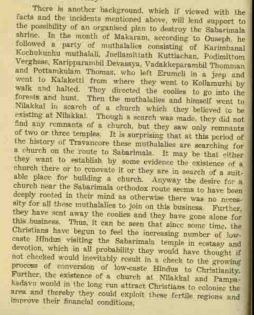
‘…There is another background, which if viewed with the facts and the incidents mentioned above, will lend support to the possibility of an organised plan to destroy the Sabarimala shrine. In the month of Makaram, according to Ouseph, he followed a party of muthalalies consisting of Karimbanal Kochukunhu Muthalali, Jnellarittath Kuttiachan, Podimittom Verghese, Karipparambil Devassya, Vadakkeparambil Thomman and Pottamkulam Thomas, who left Erumeli in a jeep and went to Kalaketti from where they went to Kollamuzhi by walk and halted. They directed the coolies to go into the forests and hunt. Then the muthalalies and himself went to Nilakkal in search of a church which they believed to be existing at Nilakkal. Though a search was made, they did not find any remnants of a church, but they saw only remnants of two or three temples. It is surprising that at this period of the history of Travancore these muthulalies are searching for a church on the route to Sabarimala. It may be that either they want to establish by some evidence the existence of a church there or to renovate it or they are in search of a suitable place for building a church. Anyway the desire for church near the Sabarimala orthodox route seems to have been deeply rooted in their mind as otherwise there was no necessity for all these muthalalies to join on this business. Further, they have sent away the coolies and they have gone alone for this business. Thus, it can be seen that since some time, the Christians have begun to feel the increasing number of low-caste Hindus visiting the Saharimala temple in ecstasy and devotion, which in all probability they would have thought if not checked would inevitably result in a check to the growing process of conversion of low-caste Hindus to Christianity. Further, the existence of a church at Nilakdkal and Pampakadavu would in the long run attract Christians to colonise the area and thereby they could exploit these fertile regions and improve their financial conditions.’
‘….The motive of the crime brought out during the investigation being religion and Christians being responsible for the offence, any information or clue leading to the detection was an impossibility in as much as all the routes leading from the plain are in majority inhabited by Christians. The surrounding estate owners are also Christians.’
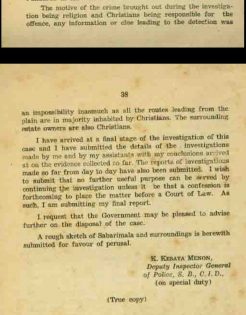
Featured image courtesy: Sadhananda Swamigal and hindutemplesguide.com.
Visit Indian History Real Truth Facebook group to view related posts. This article is part of ‘JEWELS OF BHARATAM SERIES [TM]‘ by the author.
Courtesy: Enquiry Report of Shri K. Kesava Menon, Deputy Inspector- General of Police, Special Branch, OLD (On Special Duty) on the Sabarimala temple arson case (put as it is in parts).

